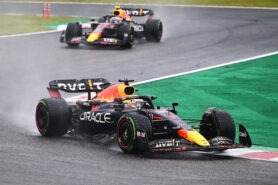Red Bull R18 specs & info

SUZUKA, JAPAN - OCTOBER 09: Max Verstappen of the Netherlands driving the (1) Oracle Red Bull Racing RB18 on his way to the grid prior to the 2022 F1 Grand Prix of Japan at Suzuka
Red Bull's F1 car for 2022
The Red Bull Racing team has a long history of pushing the limits of Formula One technology, and their latest creation, the RB18, is no exception. This cutting-edge racing machine is designed to dominate the track, and fans around the world are eagerly anticipating its debut on the F1 circuit.
One of the most striking features of the RB18 is its sleek, aerodynamic body. The car's designers have spent countless hours fine-tuning every aspect of its shape, from the nose cone to the rear wing, in order to reduce drag and maximize downforce. This allows the RB18 to cut through the air with incredible speed and agility, giving its drivers an edge in every race.
Under the hood, the RB18 boasts a powerful hybrid powertrain that combines a high-revving gasoline engine with an advanced electric motor. This innovative system delivers massive amounts of horsepower and torque, while also minimizing fuel consumption and emissions. The RB18's drivers can switch seamlessly between gasoline and electric power, allowing them to optimize performance in any situation.
Of course, no racing car is complete without a suite of high-tech sensors and data analysis tools. The RB18 is equipped with an array of cutting-edge sensors that constantly monitor the car's performance and feed data back to the team's engineers in real time. This allows the team to make rapid adjustments and fine-tune the car's settings between races, ensuring that it's always performing at peak efficiency.
Technical Specifications Red Bull RB18
Underbody and Diffuser
The biggest change with this new generation of cars lies in how they generate downforce. Designed to reduce the wake of ‘dirty’ air that hampers following cars, 2022 F1 cars zero in on the floor as the source of downforce and in effect the sport has brought back ground effect, last seen on cars in 1982. Out go the flat floors we’ve been used to for decades and in come two long tunnels that channel airflow under the car and back to the rear diffuser. The raked diffuser will fire dirty air higher than with previous cars so the wake’s energy will dissipate over a longer time before impacting a following car.
Rear Wing
The rear wing is also vastly different to previous generations. The chief goal is to reduce the wake of dirty air behind the car. The first step towards this is to get rid of rear wing end plates. These are great for generating downforce, but also for generating dirty air that disrupts the stability of a following car. The new rear wing’s curved shape not only removes endplates, but its curved shape also creates an airflow structure that collects wake from the rear wheels and funnels it into the flow coming up from the rear diffuser, helping to fire the lot high into the air, causing less instability for a following car.
Wheel Covers and Winglets
A major area of aero development for teams in recent years has been using airflow through the wheels to generate downforce and, once again, to channel dirty air outboard of the car, adding to a turbulent wake that causes instability in a following car. To remove that temptation from designers, F1 has chosen to implement wheel covers that physically prevent air being channelled through the wheels. The new rim covers are tightly defined however, so teams won’t get to play with the design to channel that turbulent air. The new cars also get a small winglet over the new 18” tyres this season. These are designed to help control the wake coming off the front tyres and direct it away from the rear wing.
Front Wing
In the hybrid era front wings were an area of huge focus for teams and increasingly complex as teams tried to find greater aerodynamic benefits. The front wing was routinely simplified in the final years of the last generation of cars, but for 2022 it has been totally reimagined. A four-element wing is attached directly to the nose and features a very simple endplate. The idea is that with the floor generating the bulk of downforce, the front wing doesn’t have to work as hard and the simplified version will also be less sensitive to the turbulent wake from a car in front.
18” Tyres
After more than half a century of 13-inch tyres, in 2022 the size increases to 18 inches. Featuring new profiles, compounds and construction, the new rubber has been designed to have a wider working range than the 13” tyres and as a result, overheating is limited and degradation is reduced, which in theory should allow drivers to race closer for longer. The new lower profile should also reduce sidewall deflection changes and the wake effect that occurs as a result, again to the benefit of close racing. Additionally, new temperatures are introduced for the tyre blankets. All tyres will now be heated to 70 degrees, rather than 100 degrees at the front and 80 degrees at the rear, as was the case previously.
Engine
Number of cylinders: 6
Number of valves: 4 per cylinder
Oil: Mobil 1
Capacity: 1,600cc
Vee angle: 90-degrees
Weight: 150kg
Max RPM: 15,000RPM
Power output: 900HP











LAST 3 F1 Fan COMMENTS